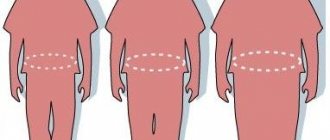( 4 ratings, average: 3.25 out of 5)
Body mass index is the optimal tool for determining health status and physical endurance. With its help, you can calculate your individual weight norm.
- Body Mass Index Formula
- Body mass index for most people
- BMI values and online calculator
- How to determine your ideal weight
- Normal BMI for women
- conclusions
A simple BMI formula helps to timely identify serious problems such as anorexia or stable weight gain.
It is necessary to calculate your body mass index for a number of reasons. One of them is globalization and, as a consequence, the absence of the problem of hunger in the civilized world. Just a hundred years ago, the average person's body weight was regulated by a low standard of living. But over the past half century, the situation with providing him with a minimum food basket has changed radically.
The abundance of food in modern society has led to two opposite consequences:
- Excessive, uncontrolled consumption of foods and the problem of overeating.
- Manic struggle with excess weight. The natural result is anorexia.
Modern man is subjected to daily “advertising violence”, both from giant food industry companies and the world’s major manufacturers of specialized drugs and dietary supplements. In addition to causing obvious damage to physical health, they increase the growth rate of psychological problems. Many of them are associated with the cult of food or the fight against it.
A cross-section of human society shows a division into two unequal parts: those who eat everything without thinking about the consequences, and those who lose their minds in the fight against excess weight.
How to find balance, a reliable balance in the tough confrontation between two points of view about proper nutrition? The golden mean exists, and it was determined a long time ago. The author of the body mass index formula is Adolphe Quetelet. The method allows you to outline a basic list of risks for a specific person. Indicate possible diseases that should be given priority attention. And take safety measures in a timely manner.
Why do you need to know your BMI?
Data from the World Health Organization indicate that obesity is currently one of the leading diseases in the world. Doctors successfully fight various kinds of pathologies, infections, and diseases. But the fight against excess weight has not yet shown good results. This is due to an incorrect lifestyle, an abundance of fast food, fatty foods. The consequences of obesity and excess weight are terrifying - type 2 diabetes, a tendency to heart attacks, disruption of the functioning of internal organs.
Body mass index may indicate problems occurring in the body:
- an increased value indicates the risk of serious diseases associated with excess weight: hypertension, diabetes, varicose veins, problems of the cardiovascular, digestive systems, internal organs;
- a reduced value is a signal of exhaustion, possible deficiencies of vitamins, minerals, and nutrients. A weakened body is less resistant to external influences. There is a decrease in local immunity and protective reactions. A lack of fat mass and a low BMI may indicate type 1 diabetes, osteoporosis, digestive disorders, mental problems, and eating disorders.
What is your body mass index?
According to WHO, half of the people on the planet die today not from dangerous infections, as in past eras. The main enemies of man are fast food, overeating, stress, “sedentary” work and “sofa” leisure.
A whole generation of people has grown up suffering from obesity and doomed to type 2 diabetes mellitus, cardiovascular diseases, osteochondrosis and many other dangerous ailments. The asymptomatic period of these pathologies can drag on for years, during which the body’s strength will slowly but surely be undermined. An increased body mass index will warn about the destructive activity of a latent disease.
In turn, a lowered BMI will signal another deviation from the norm - painful exhaustion of a person. This condition should also cause concern. An organism with insufficient fat deposits is not able to cope with its functions normally and resist diseases. A deficiency of fat tissue can be a sign of type 1 diabetes, osteoporosis, digestive disorders, breathing or mental problems.
In any case, your body mass index will allow you to come to your senses in time and begin to restore your physical shape. Of course, on the path to perfection you will need to pull yourself together, get rid of bad habits, and sacrifice destructive addictions. However, the game is worth the effort, because the most valuable thing at stake is your life.
How to calculate body mass index for women
BMI is usually calculated using Adolphe Quetelet’s formula. It was developed in the middle of the last century and takes into account only a person’s height and weight. In this case, age and other individual characteristics, such as waist or hip circumference, are not taken into account. To correctly interpret the obtained value, weight loss specialists resort to additional research: it is necessary to identify the true reasons for gaining extra pounds in order to draw up a plan for getting rid of them.
Once your BMI is determined, if it is higher than normal for your height, weight and age, it is recommended that you undergo a comprehensive examination at a weight loss clinic. It is important to determine the percentage of fat and muscle tissue. Such a serious and thorough approach to the problem may be life-saving. Why? Because fat deposits are usually concentrated in certain areas: on the stomach, thighs, and around the internal organs. Certain combinations, sizes and proportions of these deposits, which are detected during examination at a weight loss clinic, may indicate dangerous diseases. And the simple generally accepted BMI formula, of course, does not take into account all the details of the location of extra pounds.
Calculate weight using BMI (Quetelet body mass index)
table for calculating optimal weight using Quetelet body mass index
Using the Body Mass Index, you can find out in what predetermined range a person’s current weight is: deficit, normal or obese (all BMI values are shown in the table).
BMI is calculated using a formula that takes into account the initial values of height in meters and weight in kilograms. The formula looks like this: KMT = weight in kilograms: (height in meters * height in meters).
Example: a man with a height of 185 cm (1.85 m) and a weight of 88 kg will have a BMI = 88: (1.85 * 1.85) = 27.7. We look for the value in the table and understand that the index is in the range of Overweight (pre-obesity).
An important point: calculating the correct weight according to BMI does not take into account gender and age-related changes in the body.
Your ideal weight
A woman's weight is considered ideal if:
- does not cause discomfort;
- does not limit a woman when performing everyday activities;
- does not cause health problems;
- does not carry potential risks: the likelihood of developing type 2 diabetes, high blood pressure, high cholesterol, heart disease.
There are various ways to determine your ideal weight. The most common are the following:
- By body mass index. If it is normal and there are no concomitant diseases, there is no need to worry.
- Subtract 110 from your height in centimeters.
- Along the fat fold on the abdomen. The norm for women is 2-4 cm.
- Use an online calculator.
The best way to determine the value of your body mass index is to undergo a comprehensive examination using special equipment. It is available in weight loss clinics. Experts will determine the ratio of fat and muscle mass, ideal weight, indicators necessary to determine the state of health and create a diet.
How to determine your ideal weight
Disputes among scientists on this issue have not stopped for many decades. The answer has not yet been found.
There is a very simple standard formula for calculating your weight norm: Subtract 100 from your height.
Many specialized experts will call this result (in kilograms) your individual norm.
The technique does not take into account the age and proportions of the skeleton, and this reduces the accuracy of the calculation. After all, there are many different types of proportions - thin-boned (asthenics), standard, large-boned (hypersthenics).
To compensate for the lack of simple calculation, the French physician and anthropologist in the nineteenth century introduced the so-called Paul Broca formula (under his own name). He proposed an indexing system that took into account racial differences in body and skeletal structure. These are several separate formulas for determining your ideal weight. One of them is still popular among many specialists.
The ideal value is calculated as follows:
- For people shorter than 1.65 m, division by 100 is used.
- From 1.65 to 1.75 m – 105.
- From 1.75 m and above – 110.
Since the proposed method does not take into account age and structural features of the skeleton, it needs amendments.
People under thirty years of age should reduce the result by seven to ten percent. Age fifty years and older – an increase of five to seven percent. For hypersthenics – an increase of ten percent. For asthenics - deduct the same number.
Note. Calculations of normal body weight are relevant only for those who have reached the age of twenty-one. For children, adolescents and young men, it is not possible to determine the ideal weight for a number of reasons associated with significant fluctuations in all parameters taken into account.
Body mass index for men and women by age makes it possible to detect, with the best possible accuracy, a tendency to a specific type of disease.
If, for example, your body weight exceeds the norm by fifteen percent, this is an alarming signal. It should be given serious attention. The time has come to thoroughly change your diet and diet, increase physical and sports activity, and consult with medical specialists about additional measures.
Exceeding the norm by thirty percent means you need a complete change in your worldview, life activity and eating behavior.
For each time cycle of life, only its own individual food preferences are permissible. Nutrition should be appropriate for your age, weight and build. To avoid common mistakes when compiling a list of necessary products, seek help from a nutritionist. This is especially important for women in general and for women over forty in particular. They are more likely to be obese than men. It is also more difficult for them to control their weight.
Body Mass Index Formula
There is a generally accepted formula by A. Quetelet that allows you to calculate BMI. It has the form: I=m/h², where m is body weight (kg), h is height (m).
Calculating your body mass index will not take much time. The main thing is to correctly interpret the resulting value. The World Health Organization proposes the following classification based on the data obtained:
| Index value | What does the indicator say? |
| Less than 16 | There is a pronounced lack of body weight, exhaustion of the body |
| From 16 to 19 | Body weight is insufficient, there is a deficiency |
| From 19 to 25 | Weight is within normal limits |
| From 25 to 30 | There is excess weight, the stage of pre-obesity is observed |
| From 30 to 35 | Obesity type 1 |
| From 35 to 40 | Obesity type 2 |
| Over 40 | Obesity type 3 |
It is better to calculate your body mass index based on your age. The norm for age intervals for women is different, shown in the following table:
| Age | Body mass index for women by age |
| 19-25 | 19,6 |
| 25-35 | 23,3 |
| 35-45 | 23,5 |
| 45-55 | 25,3 |
| Over 55 | 27,4 |
If a woman’s body mass index shows significant excess weight or even some stage of obesity, a weight loss specialist prescribes additional tests and refers her to a psychotherapist for consultation. After all, it is important to establish the true reasons for weight gain or loss. Perhaps then it will be necessary to teach the patient to independently deal with problems leading to deviations and illnesses, and to begin to live in a completely new way. It’s not for nothing that professionals say that improving your psycho-emotional background and changing your eating habits is the key to a new, healthy body. And these are not just beautiful words, but everyday reality.
How to understand if you are overweight: calculate your body mass index
Body mass index is calculated using the formula: BMI = weight in kg / (height in m)2
For automatic calculation, use our body mass index calculator for women and men: just enter your height and weight into the excess weight calculator to calculate your body mass index for free.
Body Mass Index (BMI) Calculator
Compare the resulting number with the body mass index values in the table:
| Body mass index | Correspondence between a person's mass and his height |
| less than 16 | Severe underweight |
| 16–18,5 | Underweight |
| 18,5–25 | Norm |
| 25–30 | Excess body weight (pre-obesity) |
| 30–35 | Obesity of the first degree |
| 35–40 | Obesity of the second degree |
| 40 or more | Obesity of the third degree |
Notes: 1. You will receive an average value: ideally, you need to calculate weight for weight loss taking into account your body type, age and height. 2. Professional athletes with well-developed muscles will have a higher BMI, because muscle is heavier than fat. 3. You should not calculate BMI during pregnancy. 4. This BMI calculation is not suitable for children under 19 years of age: according to WHO, BMI for this age group is calculated differently [].
If you are obese or underweight, it is important to seek advice from a qualified specialist: any deviations from the norm can cause diseases and disruptions in the body.
To achieve and maintain a healthy weight, you need to work on:
- food;
- water balance;
- lifestyle;
- mood.
This is exactly what Amway's comprehensive Body Detox program teaches.
Online calculator for calculating BMI
An online BMI calculator is the fastest, easiest way to find the true value. There are different sites: some take into account only height and weight, others also age. The second one is more popular, since it allows you to get the most accurate value. For older people, a slight deviation from the optimal BMI value is considered normal.
The BMI calculator works simply. All that is required from a person is:
- indicate gender. Women, for example, tend to have a lower BMI;
- enter height and weight;
- Enter the full number of years or indicate the date of birth.
The BMI calculator will calculate the value in a few seconds and indicate which of the listed intervals it belongs to: deficiency, normal, pre-obese or one of the stages of obesity.
BMI calculator
Enter information about the person for whom you want to find out the body mass index. To do this, fill out the fields below and click the “Calculate” button.
Age must be between 18 and 100!
Height must be a number greater than zero!
The weight must be a number greater than zero!
Severe underweight
If the BMI value for women is less than 16, there is only one conclusion - there is a pronounced underweight. This may indicate a number of serious diseases and severe depletion of the body. Only a specialist can make an accurate diagnosis.
There are several main reasons why underweight may occur:
- insufficient food consumption: inability to eat due to work, stress, difficult life situation, conscious refusal to eat;
- diseases of the gastrointestinal tract that interfere with the absorption of vitamins, minerals, and nutrients;
- unhealthy lifestyle: unbalanced, unhealthy diet, bad habits, lack of physical activity;
- hereditary predisposition.
It is important to start treatment on time and contact competent specialists. Usually, a comprehensive methodology is required: changing eating habits, nutrition in combination with the work of a psychologist.
YOUR BMI IS UNDER 18.5: BODY WEIGHT DEFICIT
You are underweight. If your body mass index is close to 18.5, don’t despair! Start eating rationally and balancedly - a little more and your weight will return to normal, which will be beneficial for your health. We recommend that you consult a nutritionist or therapist, he will prescribe individual recommendations for you.
What is dangerous about underweight: often underweight occurs not only as a result of a malfunction of certain body systems (in this case, consult a doctor!), but also due to poor nutrition – a lack of essential vitamins. This threatens immunity damage (the body is less resistant to disease), osteoporosis (increased bone fragility), hair loss and hormonal imbalances in women.
Underweight
Typically, a BMI value below 19 indicates underweight. This is no less a serious problem than obesity, ignoring which can lead to anemia, anorexia - diseases dangerous to the body, accompanied by loss of strength, fainting, migraines, disruption of the cardiovascular and digestive systems, weakening of the immune system and the body's defense reactions.
Insufficient body weight in women may indicate the following diseases:
- neuropsychic exhaustion;
- hormonal disorders;
- overwork;
- infectious and viral diseases;
- problems in the gastrointestinal tract;
- eating disorders.
The problem of underweight should not be ignored, as the disease can take a more serious form that is life-threatening. When gaining weight, an integrated approach is important, a special technique that includes proper rest, proper nutrition, moderate physical activity, and work with a psychologist.
Ideal body mass index (BMI)
Taking into account the difference in muscle mass between the average man and woman (we do not take athletes into account), the best indicator is considered to be:
- 20-22 for women;
- 23-25 for men.
The body mass index coefficient (number) for men and women is the same, but the program interprets the result differently - you receive a calculation depending on your gender.
For example, a man with a BMI of 18 or higher has nothing to worry about, but women should not drop their weight to a BMI of 19 or lower. So the program will tell a man with a BMI of 18.5 that everything is fine, and a girl with the same body mass index will indicate that she is underweight.
Normal body weight
Normally, BMI should be from 18.5 to 25. If the resulting value is in this range, most likely there are no problems with excess weight. However, consultation with a specialist is necessary, since Quetelet’s formula:
- Does not take into account the location of fat deposits. Athletes who have a high percentage of muscle will score high, close to being pre-obese or obese. Although this is not true.
- Not suitable for pensioners. Excess weight is normal for people over 60. Their norm may be in the range of 22-26.
Weight loss specialists with many years of experience are able to accurately diagnose and identify existing dangers and predispositions. Even slim people are recommended to periodically undergo a comprehensive examination at a weight loss clinic:
- Do a clinical blood test and ESR to determine the condition of the body, check the level of glucose and glycated hemoglobin, which are responsible for the balance of insulin.
- Make a lipid profile that reflects the metabolism of fats in the body. It allows you to track cholesterol levels, exclude obesity and heart disease.
- Find out the ratio of fat and muscle mass, localization of deposits. Visceral fat, concentrated around vital organs, can cause the development of many diseases. A person can be very slim and not even think about such a problem.
Excess body weight
Experts distinguish two forms of excess body weight:
- Fat deposits are caused by external influences: lifestyle, eating habits, lack of motor and physical activity, stress. About 70% of people suffer from “obesity from laziness.”
- Fat accumulation occurs as a result of certain diseases, disorders of lipid and metabolic metabolism, and is associated with problems in the functioning of the endocrine system.
Weight gain is caused by an imbalance caused by excess food consumption, insufficient physical activity, and problems with the psycho-emotional state. It turns out that the body receives more energy than it expends.
Obesity
Obesity refers to excess fat deposits located in the subcutaneous layer, organs, and tissues. This is the most dangerous disease for the body, causing self-doubt, problems in intimate life, psycho-emotional discomfort, and disruption of internal organs. The listed problems require solutions, a competent, comprehensive approach. The technique should cover all aspects of weight loss:
- Psychology. Responsible for motivation, forming habits, getting rid of complexes, changing attitudes towards food.
- Proper nutrition, which involves changing eating habits and eating behavior. The patient will not be required to adhere to a strict diet or count calories.
- Rehabilitation. The loss of extra pounds is accompanied by sagging skin, loss of its elasticity and smoothness. How to enter the new form and accept it? Rehabilitation therapy and cosmetology will help.
- Socialization. Losing weight largely depends on the support of family, friends and acquaintances. What if they are indifferent or even against? Competent psychological assistance will help.
This technique has been repeatedly confirmed by the world scientific community and is effectively used in practice.
There are four main types of obesity:
- Excess weight accounts for 29% of body weight. The BMI of such people is in the range of 30-35.
- Excess by 30-40%, index - 35-40.
- Exceeding more than 40%. Body obesity index over 40.
- Weight is twice or more times the ideal weight. This type is considered the most dangerous.
Example of calculating body mass index
The formula from Adolphe Quetelet is not ideal, but is widely used in medical practice. It is easy to calculate your body mass index. Let's consider an example: it is necessary to determine the BMI value for a girl with a height of 168 centimeters and a weight of 65 kg. The algorithm is as follows:
- square the height in meters: 1.68×1.68=2.8;
- divide the mass in kilograms by the resulting value: 65/2.8=23;
- Body mass index is 23. It ranges from 19 to 25. Weight is normal.
Monitoring your BMI readings will help you maintain your weight and health: according to the World Health Organization, excess weight can lead to type 2 diabetes, problems with the cardiovascular system, and hypertension. Do not neglect your own well-being and health. Timely diagnosis in a weight loss clinic under the guidance of competent specialists is the best solution.
Body mass index for most people
Determining body mass index does not require special knowledge, skills or difficult mathematical calculations. The calculation formula is based on two indicators - exact weight and height.
Please note that the simplicity of the calculations does not exclude the possibility of erroneous conclusions.
In order to exclude all factors that negatively affect the results:
- Measure your height only after a night's sleep. This figure decreases throughout the day. In the evening he may “sin” by one or two centimeters.
- Use accurate scales from a reputable manufacturer. Best of all, with an electronic sensor.
- Empty your bowels and bladder before weighing.
- Measure your body weight without clothes or in underwear.
- Record as accurate readings as possible immediately after the procedure.
Note. The calculation of the BMI formula requires systematic adjustment. Measure your weight and height daily, every three days or weekly, depending on your specific conditions and circumstances.
Body Mass Index Calculation
The formula for all people involves a simple action: dividing the number of kilograms of weight by the square of the height in meters.
BMI = body weight (kg) / height (m)²
An example of calculating body mass indexes for the following parameters – height 180 cm and weight 95 kilograms: 95 (kilograms) must be divided by 3.24 (1.80 multiplied by 1.80).
We get the result: 29.32 (specific BMI indicator).
Those who are too lazy to find out their BMI using the formula themselves can use a universal online calculator. BMI will be accurately calculated after entering specific height and weight parameters. Preliminary measurement is a mandatory process.









